L-class
Design and Construction Notes
The L-class submarines were built to two distinctly different designs at four different shipyards. The two designs were from the Electric Boat Company (EB) of New York City (later Groton, CT.) and the Lake Torpedo Boat Company (LTB) of Bridgeport, CT. While very similar in military and operational capability, the two designs were vastly different in installed equipment, interior arrangement, and external appearance. The L-1 through L-4, and L-9 through L-11 were of the EB design and were built at an EB subcontractor, the Fore River Shipbuilding Co. of Quincy, MA. L-5 through L-8 were of the LTB design, with L-5 built at the Lake yard in Bridgeport, CT., the L-6 and L-7 built at Craig Shipbuilding in Long Beach, CA., and the L-8 built under license at the Portsmouth Navy Yard in Kittery, ME.
L-1 (SS-40)
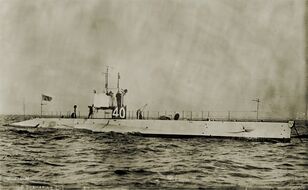
L-1 riding at anchor while on sea trials, March or April 1916, probably off Provincetown, Mass. A low-lying shore line with houses can be seen in the background, reminiscent of Cape Cod. The L-class were the first US submarines designed to carry a deck gun of any sort, in this case a 3"/23 caliber Mk 9 gun. But it wasn't until the L-9 that guns were installed during construction. The L-1 through L-8 were retrofitted later with the gun. As you can see the L-1 has no gun in this early photo.
L-2 (SS-41)

L-2 in an unknown location, approximately 1918. In July of 1918 while patrolling in the Irish Sea, a large explosion rocked the L-2 about 25 feet on her beam. A torpedo aimed at her by a German U-boat had seemingly detonated prematurely. A periscope was sighted so the L-2 immediately submerged and made an unsuccessful attempt to ram the submarine. with her primitive sonar she couldn't track the U-boat well under water, plus the U-boat had superior under water speed. Later it was suspected that a U-boat had indeed attempted to fire upon the L-2, but another U-boat, the U-65, was unknowingly in the way and was hit by the torpedo meant for L-2. Some time later when the L-2 was dry docked her hull plating was noted to be heavily dented from the close by explosion. The U-65 never returned to her port.
L-3 (SS-42)
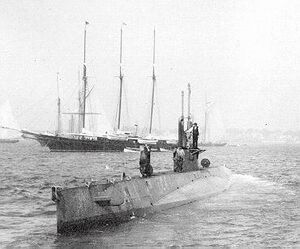
L-3 with sailing yachts, early in her career, approximately 1916. The location is unknown, but could be Newport, R.I. Notice the complete lack of a bridge structure. It would be added later during the war.
L-4 (SS-43)
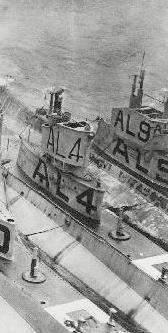
L-4 shown alongside L-9 in the summer of 1918 near Queenstown, Ireland. The post like object sticking up from the deck forward of the conning tower fairwater is the 3"/23 caliber Mk 9 deck gun, retracted into its watertight housing in the superstructure. The letter "A" was added to the exterior identification to identify her as an American submarine and to avoid confusion with the RN L-class submarines. In the late summer of 1918 while on patrol, the L-4 spotted a German U-boat on the surface charging batteries and lying motionless. The commanding officer, LCDR Lewis Hancock, Jr., fired a torpedo at the submarine. The Germans saw the torpedo and quickly sped forward and dived, evading the torpedo. In a later incident, the L-4 later had almost the same situation and the same result, the torpedo missed. The Mark 6 and 7 torpedoes in use at the time were known to be touchy. If bumped hard the gyro would malfunction and the weapon would stray off course.
L-5 (SS-44)
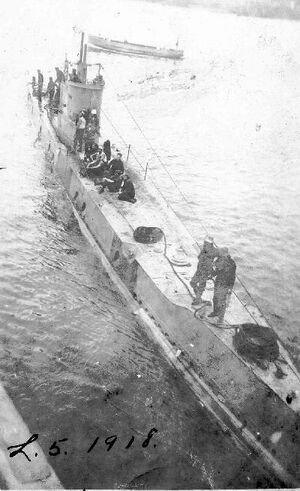
This photo of L-5 was taken in the early fall of 1918, possibly in Bermuda. The boat is maneuvering alongside a pier, getting ready to tie up after a run at sea. Lines have been flaked out on deck and the two sailors on the bow seem to be ready to throw a "heevey", a small diameter line with a weight on the end. It is used to throw over to a pier or tender, so that the large, heavy mooring line can then be pulled over and secured. L-5 was a Lake design boat built at Lake's yard in Bridgeport, CT.
L-6 (SS-45)
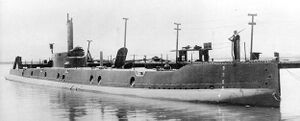
L-6 is shown under construction by the Craig Shipbuilding Company, Long Beach, CA., June 30, 1917. Note the circular flood port openings for the watertight superstructure, the open oval shaped torpedo loading hatch, and the very incomplete state of the conning tower fairwater. Although not yet in commission, there is a sailor standing watch on the forward deck with a rifle.
L-7 (SS-46)
L-8 (SS-48)
L-9 (SS-49)
L-10 (SS-50)
L-11 (SS-51)
General L-class photos
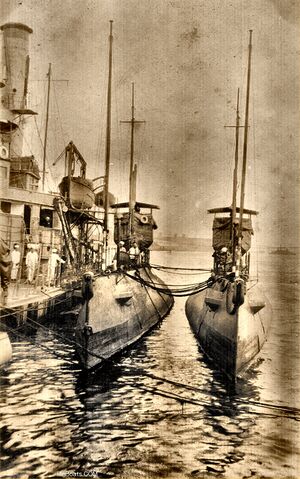
Here we have here two unidentified L-class submarines. The unique shape of the bow planes pivot housings and the unique shaped “bullnose” on the tip of the bow are identifiers to this class. The two flat rectangular covers, one on top of the other over the bow planes pivots can be seen. This cover was unique to the L-1, L-2, L-3 and L-4 and then again with the L-9, L-10, and the L-11. Submarines L-5 through L-8 were built to the Lake Co. design and did not have these pivot covers. This variant of the “L” class of submarine were commissioned by late 1916. The L-6 thru L-8 variant were commissioned in 1917. L-5 was commissioned in 1918.
Both submarines have a tall forward radio mast. In looking in other archives we have seen only the L-1 with such a mast. So, possibly one of these two vessels could be the L-1 but it could just be coincidence that there only exists one image, other than this one, with these masts. Radio was new and trials were being made all the time.
Neither submarine have any sign of having “C” or “J” tube listening gear installed at this point. So, a possible date is closer to commissioning, perhaps a late 1916 or early 1917 time frame. But for sure this is before the US entered WW I on April 6, 1917. The submarines still are using the old fashioned pre-war canvas bridge shelters that proved too flimsy to withstand the pressures of diving with it erected. They were too time consuming to try and take down in actual war time conditions.
The British, having been at war with Germany for two years, taught their American cousins a lot of practical things about actual submarine warfare including the development and use of the metal chariot bridge surround that could remain in place while diving and withstand those pressures. Soon almost all US submarines had this revision installed.
Once these subs reached Europe, the British, to avoid confusing their “L” class submarines with the American “L” class subs required the American subs to paint an “A” in front of their numbers. All combatants still wore hull identification at this time. In later conflicts all ID was painted out so an enemy could not keep track of sub movements, this is even done to this day.
These two submarines are moored to a Monitor-type tender that is also not identified but could possibly be the USS Tonopah (BM-8). Three sailors are standing on the tender's deck. There also seem to be at least two people each on the submarines’ decks.